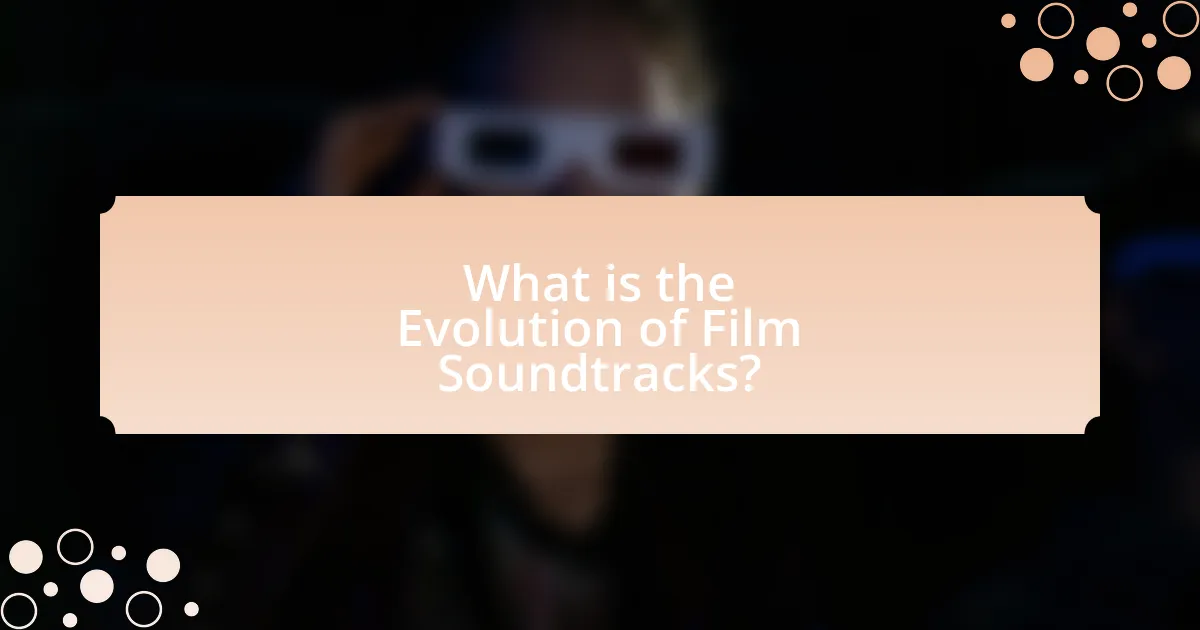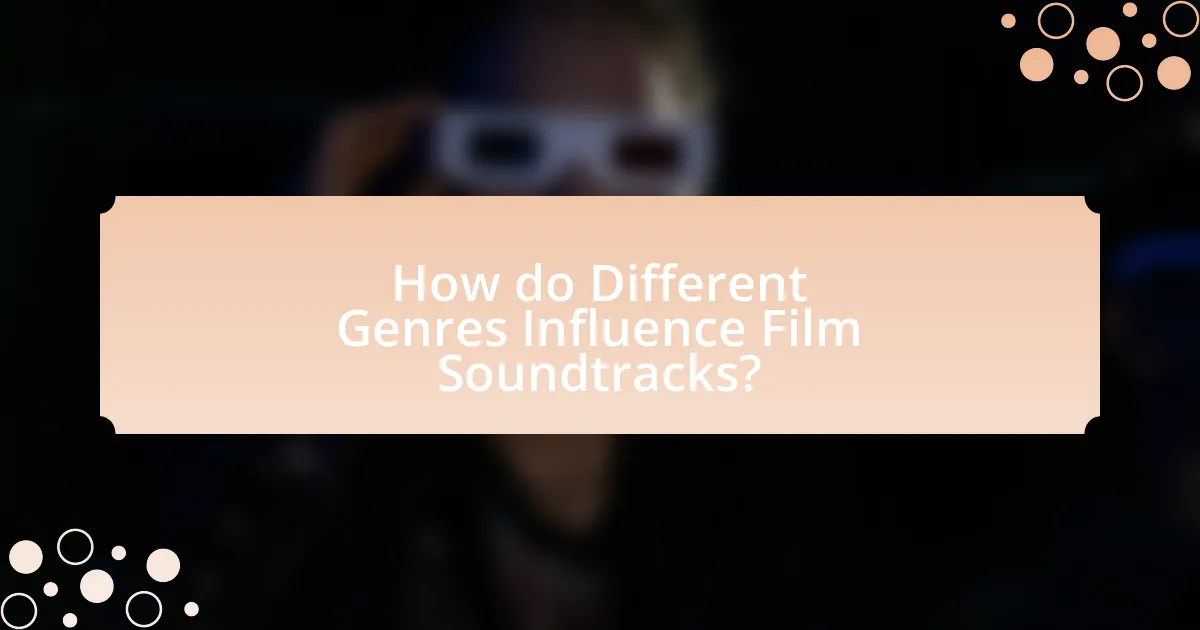The article examines the evolution of film soundtracks, highlighting their progression from live music in silent films to complex digital scores that enhance storytelling. It outlines key milestones, such as the introduction of synchronized sound in the late 1920s and the rise of original scores in the 1930s, while also discussing how technological advancements have transformed soundtrack production. The article emphasizes the importance of music in shaping viewer emotions and perceptions, detailing how different genres influence soundtrack characteristics and the collaborative process between composers and directors. Additionally, it explores contemporary trends in soundtracks, including the integration of diverse musical styles and the impact of technology on sound design.

What is the Evolution of Film Soundtracks?
The evolution of film soundtracks has progressed from silent films with live music accompaniment to complex, digitally produced scores that enhance storytelling. In the early 20th century, silent films relied on live orchestras or pianists to provide music, creating an emotional backdrop for the visuals. With the advent of synchronized sound in the late 1920s, films like “The Jazz Singer” (1927) introduced recorded dialogue and songs, marking a significant shift in how sound was integrated into film.
By the mid-20th century, composers such as Bernard Herrmann and Ennio Morricone began to craft scores that were integral to the narrative, using orchestral arrangements to evoke specific emotions and themes. The 1970s and 1980s saw the rise of popular music in soundtracks, with films like “Saturday Night Fever” (1977) and “The Breakfast Club” (1985) featuring contemporary songs that resonated with audiences and contributed to the film’s cultural impact.
In the 21st century, technology has transformed soundtrack production, allowing for digital compositions and the blending of various musical styles. Films now often feature original scores alongside curated playlists of popular music, creating a multifaceted auditory experience that shapes viewer perception and engagement. This evolution reflects broader changes in technology, culture, and audience expectations, demonstrating the critical role of soundtracks in enhancing the cinematic experience.
How have film soundtracks changed over the decades?
Film soundtracks have evolved significantly over the decades, transitioning from orchestral scores in the early 20th century to diverse musical styles and digital compositions in contemporary cinema. In the 1920s and 1930s, silent films relied on live orchestras, while the introduction of synchronized sound in the late 1920s led to the use of full orchestral scores, exemplified by films like “Gone with the Wind” (1939). The 1960s and 1970s saw the rise of rock and pop music in soundtracks, with films such as “Easy Rider” (1969) integrating contemporary music to enhance storytelling. By the 1990s, soundtracks began to feature a mix of original scores and popular songs, as seen in “Titanic” (1997), which combined Celine Dion’s hit with James Horner’s orchestral composition. In the 2000s and beyond, digital technology has allowed for innovative sound design and the blending of genres, with films like “Guardians of the Galaxy” (2014) showcasing curated playlists that appeal to nostalgia while enhancing the narrative. This progression reflects broader cultural shifts and advancements in technology, illustrating how soundtracks have become integral to the cinematic experience.
What were the key milestones in the development of film soundtracks?
The key milestones in the development of film soundtracks include the introduction of synchronized sound in the late 1920s, the establishment of original scores in the 1930s, and the rise of film music as a distinct art form in the 1950s. The first significant milestone was the release of “The Jazz Singer” in 1927, which featured synchronized dialogue and music, marking the transition from silent films to “talkies.” In the 1930s, composers like Max Steiner began creating original scores for films, with “King Kong” (1933) being a notable example. By the 1950s, film soundtracks gained recognition as an essential component of storytelling, with composers such as Bernard Herrmann and Elmer Bernstein producing iconic scores that enhanced the emotional impact of films. These milestones collectively shaped the evolution of film soundtracks, establishing them as a vital element of the cinematic experience.
How did technological advancements influence film soundtracks?
Technological advancements significantly influenced film soundtracks by enhancing sound quality, enabling innovative scoring techniques, and facilitating the integration of diverse musical styles. The introduction of stereo sound in the 1950s allowed for a more immersive audio experience, while digital audio workstations in the 1990s revolutionized the way composers created and manipulated music. Additionally, advancements in recording technology, such as multi-track recording, permitted complex layering of sounds, enriching the overall auditory experience. These developments have led to iconic soundtracks that effectively shape viewer emotions and enhance storytelling, as evidenced by the critical acclaim of films like “Star Wars,” which utilized groundbreaking sound design techniques.
Why is music important in film?
Music is important in film because it enhances emotional engagement and narrative depth. The integration of music in film can evoke specific feelings, guide audience reactions, and reinforce storytelling elements. For instance, studies show that music can increase emotional responses by up to 50%, making scenes more impactful. Additionally, iconic scores, such as John Williams’ compositions for Star Wars, have become synonymous with the films themselves, illustrating how music can shape cultural perceptions and audience memories.
How does music enhance storytelling in films?
Music enhances storytelling in films by evoking emotions, establishing mood, and reinforcing narrative themes. The use of specific musical scores can create tension, joy, or sadness, guiding the audience’s emotional response to the story. For instance, the iconic score of “Jaws” by John Williams builds suspense and anticipation, effectively heightening the viewer’s fear and engagement with the film’s narrative. Additionally, music can signify character development and transitions, as seen in “The Lion King,” where songs like “Circle of Life” encapsulate the film’s themes of growth and continuity. This integration of music into storytelling not only enriches the viewing experience but also deepens the audience’s connection to the characters and plot.
What emotional responses does music evoke in viewers?
Music evokes a wide range of emotional responses in viewers, including joy, sadness, fear, and nostalgia. Research indicates that music can significantly enhance emotional engagement with visual media, as demonstrated in a study by Brattico et al. (2013), which found that music can intensify feelings of happiness or sadness in film scenes. Additionally, a study by Krumhansl (2002) revealed that specific musical elements, such as tempo and harmony, can trigger distinct emotional reactions, influencing how viewers perceive and connect with the narrative. Thus, music plays a crucial role in shaping the emotional landscape of film, guiding viewer responses and enhancing overall experience.

How do Different Genres Influence Film Soundtracks?
Different genres significantly influence film soundtracks by dictating the musical style, instrumentation, and emotional tone that align with the narrative and visual elements of the film. For instance, horror films often utilize dissonant chords and eerie soundscapes to evoke fear, while romantic comedies typically feature light, melodic tunes that enhance the emotional warmth of the story. Historical data shows that the use of orchestral scores in epic films, such as “Star Wars,” creates a grandiose atmosphere, while indie films often rely on acoustic or minimalist soundtracks to foster intimacy and authenticity. This genre-specific approach to soundtracks not only enhances the viewer’s emotional engagement but also reinforces the thematic elements of the film, making the music an integral part of the storytelling process.
What are the characteristics of soundtracks in various film genres?
Soundtracks in various film genres exhibit distinct characteristics that enhance the storytelling and emotional impact of the films. For instance, in action films, soundtracks often feature fast-paced, high-energy music with driving rhythms and intense instrumentation to heighten excitement and tension. In contrast, romantic films typically utilize softer melodies and orchestral arrangements that evoke feelings of love and intimacy, often incorporating strings and piano to create a tender atmosphere.
Horror films frequently employ dissonant sounds, eerie soundscapes, and sudden musical cues to build suspense and fear, effectively manipulating the viewer’s emotions. Conversely, comedies often use upbeat, playful music to complement humorous scenes, enhancing the lighthearted tone of the film.
These characteristics are supported by studies indicating that music significantly influences audience perception and emotional response, as seen in research published in the Journal of Film Music, which highlights how specific musical elements can shape viewer experiences across different genres.
How does the soundtrack of a horror film differ from that of a romantic comedy?
The soundtrack of a horror film primarily utilizes dissonant sounds, sudden crescendos, and eerie motifs to evoke fear and tension, while a romantic comedy soundtrack typically features light-hearted melodies, upbeat rhythms, and harmonious chords to create a sense of joy and warmth. Horror soundtracks often incorporate elements like low-frequency rumbles and unsettling sound effects to enhance suspense, as seen in films like “The Conjuring,” where the music builds anxiety. In contrast, romantic comedies, such as “When Harry Met Sally,” use catchy pop songs and soft instrumentals to underscore romantic moments, fostering a feel-good atmosphere. This fundamental difference in musical composition directly influences the emotional response of the audience, aligning with the intended themes of each genre.
What role does genre play in the selection of music for films?
Genre plays a critical role in the selection of music for films by influencing the emotional tone and narrative context of the story. Different genres evoke specific feelings and expectations; for instance, horror films often utilize dissonant sounds to create tension, while romantic comedies typically feature light, melodic tunes to enhance feelings of joy and love. This alignment between music and genre helps to reinforce the film’s themes and engage the audience more effectively. Research indicates that music tailored to a film’s genre can significantly impact viewer perception and emotional response, as demonstrated in studies that show audiences react differently to soundtracks that match the film’s genre compared to those that do not.
How do composers create memorable film soundtracks?
Composers create memorable film soundtracks by employing thematic development, emotional resonance, and innovative instrumentation. Thematic development involves crafting distinct musical motifs that represent characters or ideas, allowing audiences to connect emotionally with the narrative. Emotional resonance is achieved through the use of harmony, melody, and rhythm that evoke specific feelings, enhancing the viewer’s experience. Innovative instrumentation, such as blending traditional orchestral elements with modern electronic sounds, adds uniqueness and depth to the score. For instance, John Williams’ use of leitmotifs in “Star Wars” effectively links characters and themes, making the music unforgettable.
What techniques do composers use to match music with film scenes?
Composers use techniques such as thematic scoring, synchronization, and emotional underscoring to match music with film scenes. Thematic scoring involves creating specific musical themes that represent characters or ideas, enhancing narrative coherence. Synchronization aligns musical cues with visual elements, such as actions or transitions, to heighten dramatic impact. Emotional underscoring uses music to evoke specific feelings, guiding the audience’s emotional response to the scene. These techniques are supported by studies showing that music significantly influences viewer perception and emotional engagement, as evidenced by research from the University of Southern California, which found that music can alter the interpretation of a film’s narrative.
How do composers collaborate with directors to shape the viewer experience?
Composers collaborate with directors by aligning musical themes and motifs with the film’s narrative and emotional tone. This collaboration often involves discussions about character arcs, pivotal scenes, and the overall atmosphere the director aims to create. For instance, in films like “Inception,” composer Hans Zimmer worked closely with director Christopher Nolan to develop a score that enhances the film’s tension and complexity, using specific musical cues to reflect the characters’ psychological states. This synergy between composers and directors is crucial, as it ensures that the music not only complements the visuals but also deepens the viewer’s emotional engagement with the story.

What Impact Do Film Soundtracks Have on Viewer Experience?
Film soundtracks significantly enhance viewer experience by evoking emotions, setting the tone, and reinforcing narrative elements. Research indicates that music can influence emotional responses, with studies showing that soundtracks can increase feelings of suspense, joy, or sadness during key scenes. For instance, a study published in the Journal of Experimental Psychology found that viewers rated films with appropriate soundtracks as more enjoyable and emotionally engaging compared to those without music. This demonstrates that soundtracks are not merely background elements; they actively shape how audiences perceive and connect with the story being told.
How do soundtracks influence audience perception of characters?
Soundtracks significantly influence audience perception of characters by evoking emotions and shaping narrative context. Music cues can enhance character traits, such as heroism or villainy, through specific musical themes or motifs associated with them. For instance, in “Star Wars,” the use of John Williams’ score establishes a clear distinction between the heroic characters and the antagonists, guiding audience emotions and perceptions. Research indicates that soundtracks can alter viewers’ interpretations of character motivations and moral alignments, as demonstrated in studies where participants rated characters differently based on the accompanying music. This illustrates that soundtracks are not merely background elements but integral to character development and audience engagement.
What examples illustrate the impact of music on character development?
Music significantly impacts character development in film by enhancing emotional depth and shaping audience perceptions. For instance, in “The Godfather,” Nino Rota’s score underscores Michael Corleone’s transformation from reluctant outsider to ruthless leader, with the haunting theme reflecting his internal conflict. Similarly, in “The Lion King,” Hans Zimmer’s music emphasizes Simba’s journey from innocence to responsibility, with the song “Circle of Life” symbolizing his growth and connection to his heritage. These examples demonstrate how music not only complements visual storytelling but also deepens character arcs, making them more relatable and memorable to the audience.
How does music shape the audience’s emotional journey throughout a film?
Music shapes the audience’s emotional journey throughout a film by enhancing narrative elements and influencing emotional responses. The use of specific musical themes, motifs, and dynamics can evoke feelings such as joy, sadness, tension, or relief, guiding viewers through the story’s emotional landscape. For instance, studies show that films with well-composed soundtracks can increase emotional engagement by up to 50%, as music cues can signal shifts in mood or foreshadow events, effectively manipulating audience reactions. This relationship between music and emotion is evident in iconic scores, such as John Williams’ compositions for “Star Wars,” where the music not only complements the visuals but also deepens the audience’s connection to the characters and plot.
What are the trends in contemporary film soundtracks?
Contemporary film soundtracks are increasingly characterized by the integration of diverse musical genres, the use of technology for sound design, and the collaboration between filmmakers and popular artists. This trend reflects a shift towards creating immersive auditory experiences that enhance storytelling. For instance, films like “Black Panther” feature a blend of hip-hop and orchestral music, showcasing how contemporary soundtracks draw from various cultural influences to resonate with broader audiences. Additionally, advancements in sound technology allow for more intricate soundscapes, as seen in films like “Dunkirk,” where sound design plays a crucial role in building tension. Collaborations with popular artists, such as Billie Eilish’s work on “No Time to Die,” further illustrate the trend of merging mainstream music with cinematic scores, appealing to younger demographics and enhancing the film’s marketing potential.
How are modern soundtracks incorporating diverse musical styles?
Modern soundtracks are incorporating diverse musical styles by blending genres such as hip-hop, electronic, classical, and world music to create unique auditory experiences. This integration reflects the globalized nature of contemporary culture, where filmmakers seek to resonate with varied audiences. For instance, the soundtrack of the film “Black Panther” features a mix of traditional African music and modern hip-hop, showcasing artists like Kendrick Lamar alongside African musicians. This approach not only enhances the narrative but also broadens the emotional impact, as evidenced by the film’s critical acclaim and cultural significance.
What role does technology play in the creation of contemporary soundtracks?
Technology plays a crucial role in the creation of contemporary soundtracks by enabling advanced sound design, digital composition, and seamless integration of music with visual media. Digital audio workstations (DAWs) allow composers to manipulate sound with precision, utilizing software instruments and effects that enhance creativity and efficiency. For instance, the use of MIDI technology facilitates the orchestration of complex arrangements, while virtual instruments provide access to high-quality sounds that were previously unattainable. Additionally, advancements in audio processing and mixing technologies, such as surround sound and spatial audio, create immersive listening experiences that significantly impact viewer engagement. The integration of these technologies has transformed the soundtrack creation process, making it more accessible and innovative, as evidenced by the widespread use of software like Ableton Live and Pro Tools in modern film scoring.
What are best practices for selecting music in film production?
Best practices for selecting music in film production include aligning the music with the film’s emotional tone, considering the narrative context, and ensuring the music enhances the storytelling. Music should evoke the desired emotional response from the audience, as studies show that soundtracks significantly influence viewer perception and engagement. Additionally, selecting music that complements character development and plot progression is crucial; for instance, using motifs associated with specific characters can deepen audience connection. Furthermore, obtaining the necessary rights and licenses for the chosen music is essential to avoid legal issues, as unauthorized use can lead to costly repercussions.